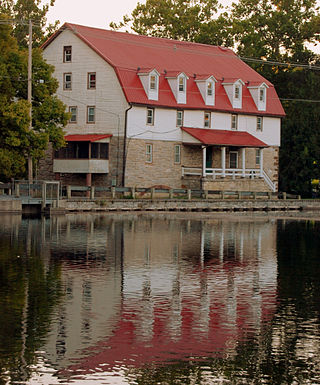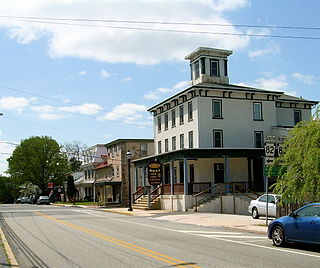
Tifton Commercial Historic District, in Tifton in Tift County, Georgia, is a historic district that was listed on the National Register of Historic Places (NRHP) in 1986 and expanded in 1994. The original listing was portions of 10 blocks including buildings from the 1890s to the late 1930s, most built of brick.

Brookville Historic District is a national historic district located at Brookville, Jefferson County, Pennsylvania. The district includes 263 contributing buildings in the central business district and surrounding residential areas of Brookville. The buildings date between about 1838 and 1930, and include notable examples of vernacular and high style Late Victorian style architecture. Notable buildings include the Judge Elijah Heath House (1836), Railroad House Hotel (1851), Blood Block (1875-1876), Marlin Opera House Block (1883-1884), McKnight Building, Northside School (1939), Methodist Episcopal Church, Holy Trinity Episcopal Church (1872), Jenks Foundry (1878), Brookville Y.M.C.A. (1915), Columbia Theater (1918-1919), Jefferson County Courthouse (1867), Brookville Borough Building, and U.S. Post Office. Located in the district and separately listed are the Brookville Presbyterian Church and Manse, Joseph E. Hall House, and Gray-Taylor House.

The Muncy Historic District is a national historic district that is located in Muncy, Lycoming County, Pennsylvania.

Boiling Springs Historic District is a national historic district located at Boiling Springs, Cumberland County, Pennsylvania. The district includes 127 contributing buildings, 1 contributing site, and 1 contributing structure associated with its role as an early iron manufacturing center and surrounding residential areas of Boiling Springs. Most of the contributing buildings date to the mid-19th century starting in 1845, with a few dated to the early period of development. The oldest buildings are a grist mill, the ironmaster's, Michael Ege, mansion (1795), and the restored Boiling Springs Tavern (1832). Other notable non-residential buildings include the former stone stables (1829) and forge building (1850s). Residential areas include notable examples of the Bungalow/craftsman, Late Victorian, and Federal styles. The contributing structure is a stone three-arched bridge (1854).

Carlisle Historic District is a national historic district located at Carlisle, Cumberland County, Pennsylvania. The district includes 1,011 contributing buildings, 1 contributing site, and 1 contributing object in the central business district and surrounding residential areas of Carlisle. Most of the contributing buildings date to the mid- to late-19th century, with a few dated to the 18th century. Residential areas include notable examples of the Late Victorian and Federal styles. Notable non-residential buildings include the Cumberland County Courthouse (1845-1846), St. John's Episcopal Church, Cumberland County Prison, First Lutheran Church, Tavern, First Presbyterian Church, Theatre, Fire House, Grace United Methodist Church, and St. Patrick's Church.

Shippensburg Historic District is a national historic district located at Shippensburg, Cumberland County, Pennsylvania. The district includes 324 contributing buildings in the central business district and surrounding residential areas of Shippensburg. Most of the contributing buildings date to the mid- to late-19th century, with a few dated to the mid-18th century. Residential areas include notable examples of the Late Victorian and Vernacular Georgian styles. The oldest buildings are log and stone structures and include the Shippen House and Widow Piper's Tavern. Other notable buildings are the Rippey House, William Brookins House, Steward-Goodhart House, Methodist Church, Lutheran Church, and Presbyterian Church.

The Uniontown Downtown Historic District is a national historic district that is located in Uniontown, Fayette County, Pennsylvania.

Chambersburg Historic District is a national historic district centered on the Memorial Fountain and Square of Chambersburg in Franklin County, Pennsylvania. The district includes 159 contributing buildings in the central business district and immediately surrounding residential area of Chambersburg. The district has a number of notable examples of Georgian and Italianate style architecture. Notable buildings include the St. Paul United Methodist Church (1896), Professional Arts Building, Cumberland Valley National Bank, Cumberland Valley Railroad Station, First United Brethren Church (1899), firehouse, Presbyterian Church of the Falling Spring (1803), and the Suesserott House. Located in the district and separately listed are the Franklin County Jail, Franklin County Courthouse, John Brown House, Masonic Temple, Townhouse Row, and the Zion Reformed Church.

The Waynesburg Historic District is a national historic district that is located in Waynesburg, Greene County, Pennsylvania.

The Lititz Moravian Historic District is a national historic district that is located in Lititz, Lancaster County, Pennsylvania.

The Girard Avenue Historic District is a national historic district which is located in the Cabot neighborhood of Philadelphia, Pennsylvania, United States.

Elverson Historic District is a national historic district located in Elverson, Chester County, Pennsylvania. The district includes 133 contributing buildings, 3 contributing sites, and 4 contributing structures in the central business district and surrounding residential areas of Elverson. The district includes a variety of residential, commercial, and institutional buildings with examples of Bungalow/craftsman, Georgian, and Gothic Revival architecture. Contributing buildings date from about 1750 to about 1930. Notable buildings include "The Bank House", train station (1870), Springfield M.E. Church (1869), Blue Rock Hotel (1860), Dengler Bro. Store, Whoye Horse Tavern (1811), The Creamery (1906), and Springfield School (1873). One of the contributing structures is the railroad car "Baltimore County."

East Lancaster Avenue Historic District is a national historic district located in Downingtown, Chester County, Pennsylvania. The district includes 121 contributing buildings and 1 contributing structure in Downingtown. The buildings include a number of notable examples of Georgian style dwellings dated to the early- to mid-18th century. Later notable dwellings are examples of the Federal and Victorian styles. Located in the district and separately listed are the Downingtown Log House and General Washington Inn.

Coatesville Historic District is a national historic district located in Coatesville, Chester County, Pennsylvania. The district includes 457 contributing buildings in the central business district and surrounding residential areas of the city of Coatesville. The buildings date from the mid-18th century to 1937, with most built between 1850 and 1924. They are mostly two- and three-story commercial buildings constructed of brick. They include notable examples of the Gothic and Italianate styles. Notable buildings include the Fleming House, Brandywine Mansion, National Bank of Chester Valley (1917), St. Cecelia's Church (1870), Beth Israel Synagogue (1925), and Coatesville High School (1915). The district includes the separately listed Lukens Main Office Building, and "Terracina."

Accomac Historic District is a national historic district located at Accomac, Accomack County, Virginia. The district encompasses 158 contributing buildings in the town of Accomac, mainly grouped into two periods of construction. From its founding in 1786 through the second quarter of the nineteenth century, several residential, commercial, governmental, and religious structures were built in the core of Accomac, representing both high-style and vernacular examples of late Georgian, Federal, and Greek Revival styles. Notable structures surviving from this period include the rectory of St. George's Episcopal Parish ; the Seymour House (1791-1815); Roseland (1750-1850); Seven Gables (1786-1905); Rural Hill, and the Francis Makemie Presbyterian Church (1840). The second period of construction reflected in the town dates to the last quarter of the nineteenth century, when the arrival of the New York, Philadelphia, and Norfolk Railroad spawned renewed growth and economic prosperity in Accomack County following the Civil War. These buildings also display both high-style and vernacular expressions of Victorian Era styles, including Second Empire, Italianate, Gothic Revival, and Romanesque. Notable structures from this time period include Bayly Memorial Hall, the County Clerk's Office (1887), the Accomack County Courthouse (1899), and houses found in the Lilliston Avenue extension of the town built in the 1880s-1890s. There are also contributing structures dating from the first quarter of the twentieth century, including the Drummondtown Baptist Church (1914), Drummondtown United Methodist Church (1920), and the former hotel at the town square (1925).

Hope Mills Historic District is a national historic district located at Hope Mills, Cumberland County, North Carolina. It encompasses 61 contributing buildings and 3 contributing sites in the central business district of Hope Mills. Ii includes industrial, commercial, religious, and residential buildings and includes notable examples of Federal and Late Victorian style architecture. Notable buildings include the (former) Hope Mills Manufacturing Company buildings, Rockfish Manufacturing Company, Colin MacRae House, Christ Episcopal Church, Lebanon Masonic Lodge No. 391, and Alice L. Gilbert Store.
Benson Historic District is a national historic district located at Benson, Johnston County, North Carolina. It encompasses 104 contributing buildings in the town of Benson. It includes notable examples of Late Victorian and Bungalow / American Craftsman style architecture and buildings dating from about 1900 to 1930. It includes commercial, residential, ecclesiastical, and educational structures. Notable buildings include the Farmers Commercial Bank (1921), C. T. Johnson Building (1910), James E. Wilson Livery Stable· and Store, Carolina-Parrish Hotel, Boon-Lawhorn House, Lonnie Stevens House, Dr. Parker-Allen House, Baptist Church (1914-1915), United Methodist Church (1917), and Benson Elementary School.

Cumberland Historic District is a national historic district located at Cumberland, Indiana. It encompasses 91 contributing buildings in the Cumberland section of Indianapolis. The district developed between about 1831 and 1950, and includes representative examples of Folk Victorian and Bungalow / American Craftsman style architecture. Notable contributing resources include the Cumberland Bank (1907), Masonic Lodge, Miller's Lunch, and First Baptist Church (1912-1913).
Commercial Community Historic District is a national historic district located at Lexington, Lafayette County, Missouri. The district encompasses 106 contributing buildings and 1 contributing structure in the central business district and surrounding residential area of Lexington. It developed between about 1830 and 1930, and includes representative examples of Late Victorian and Gothic Revival style architecture. Located in the district is the separately listed Lafayette County Courthouse. Other notable buildings include the Lexington Racquetball Club, Missouri Public Service Storage Building, Franklin Diner, Wright House, Goehner's Marbleworks, First Presbyterian Church, Municipal Auditorium (1930), Leiter Apartments, Lafayette County Sheriff's Office and Jail (1939), Morrison Wentworth Bank Building, and Winkler Theatre.

The Middlesboro Downtown Commercial District in Middlesboro, Kentucky is a 37 acres (15 ha) historic district which was listed on the National Register of Historic Places in 1983.






















